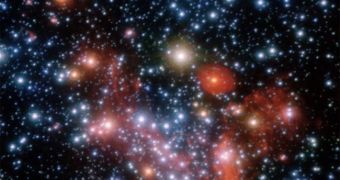It's impossible to observe black holes directly with today's technology, especially since they're, well, black, and no light escapes so that their shape and existence can be detected. But scientists are pretty sure that almost (if not all) galaxies hold one such mysterious object at their core. This is why a long, assiduous and accurate study, which took 16 years, was performed by means of ESO's telescopes in order to detect the presence of our own.
Our galaxy, the Milky Way, is said to have a massive black hole at its center, called Sagittarius A* (Sagittarius A Star). The European Southern Observatory (ESO) used its telescopes (New Technology Telescope and the Very Large Telescope) to track the movement and changes in 28 stars orbiting the innermost area of the galaxy. The conclusions of the study have shed new light, so to speak, on the existence and features of the black hole.
First, it was inferred that its mass was approximately that of 4 million Suns and that it was located some 27,000 light years (multiply by 10 trillion to obtain the distance in km) away from the Earth. Also, 95% of the mass that alters the nearby stars' behavior was determined to come from Sagittarius A*.
"The stars in the innermost region are in random orbits, like a swarm of bees," explained the main author of the study, Stefan Gillessen, from the Max-Planck-Institute for Extraterrestrial Physics in Garching, close to Munich, Germany. "However, further out, six of the 28 stars orbit the black hole in a disc. In this respect the new study has also confirmed explicitly earlier work in which the disc had been found, but only in a statistical sense. Ordered motion outside the central light-month, randomly oriented orbits inside – that's how the dynamics of the young stars in the Galactic Centre are best described."
"Undoubtedly the most spectacular aspect of our long term study is that it has delivered what is now considered to be the best empirical evidence that supermassive black holes do really exist. The stellar orbits in the Galactic Center show that the central mass concentration of four million solar masses must be a black hole, beyond any reasonable doubt," shared Reinhard Genzel, leader of the study team at the same institute.

 14 DAY TRIAL //
14 DAY TRIAL //